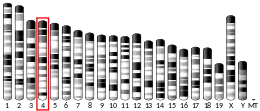SRARP
Steroid Receptor Associated and Regulated Protein (SRARP) in humans is a protein encoded by a gene of the same name with two exons that is located on chromosome 1p36.13.[5][6] SRARP contains 169 amino acids and has a molecular weight of 17,657 Da.[7]
| SRARP | |||||||||||||||||||||||||
|---|---|---|---|---|---|---|---|---|---|---|---|---|---|---|---|---|---|---|---|---|---|---|---|---|---|
| Identifiers | |||||||||||||||||||||||||
| Aliases | SRARP, ERRF, C1orf64, chromosome 1 open reading frame 64, steroid receptor associated and regulated protein | ||||||||||||||||||||||||
| External IDs | MGI: 2685540 HomoloGene: 18717 GeneCards: SRARP | ||||||||||||||||||||||||
| |||||||||||||||||||||||||
| |||||||||||||||||||||||||
| |||||||||||||||||||||||||
| Orthologs | |||||||||||||||||||||||||
| Species | Human | Mouse | |||||||||||||||||||||||
| Entrez | |||||||||||||||||||||||||
| Ensembl | |||||||||||||||||||||||||
| UniProt | |||||||||||||||||||||||||
| RefSeq (mRNA) | |||||||||||||||||||||||||
| RefSeq (protein) | |||||||||||||||||||||||||
| Location (UCSC) | Chr 1: 16 – 16.01 Mb | Chr 4: 141.43 – 141.44 Mb | |||||||||||||||||||||||
| PubMed search | [3] | [4] | |||||||||||||||||||||||
| Wikidata | |||||||||||||||||||||||||
| |||||||||||||||||||||||||
Expression and function in breast cancer
SRARP is co-expressed with the estrogen receptor (ER) and androgen receptor (AR) in breast cancer.[8][9] In the ER-positive breast cancer cells, SRARP is involved in the transcriptional activities of ER and has shown an interaction with ER using the transient transfection of cells with SRARP and ER constructs.[10][11] In addition, in AR+ breast cancer cells, SRARP interacts with the endogenous AR protein and acts as a transcriptional corepressor of AR.[9] Furthermore, the activation of either AR or ER negatively regulates SRARP expression in breast cancer cells.[9][10]
Tumor suppressor function in malignancies
SRARP and HSPB7[12] are gene pairs that are positioned 5 kb apart on chromosome 1p36.13.[13] It is notable that the loss of chromosome 1p36.1 is common in malignancies, occurring in 34% of tumors[14][15] SRARP and HSPB7 are broadly inactivated in malignancies by epigenetic silencing, copy-number loss, and less frequently by somatic mutations.[13] In addition, overexpression of SRARP or HSPB7 leads to tumor suppressor effects in cancer cell lines.[13] Another similar molecular feature between SRARP and HSPB7 is the fact that both of these proteins interact with the 14-3-3 protein.[9][13] Furthermore, SRARP is a potential cancer biomarker and SRARP inactivation predicts poor clinical outcome in malignancies and adjacent normal tissues using the analysis of large genomic datasets[13]
| Approved Symbol | SRARP |
|---|---|
| Approved Name | Steroid Receptor Associated and Regulated Protein |
| HGNC ID | HGNC:28339 |
| Previous Symbol | C1orf64 |
| Alias Symbols | MGC24047, ERRF |
| Chromosome location | 1p36.13 |
| Ensembl | ENSG00000183888 |
| UniProt | Q8NEQ6 |
| NCBI Gene | 149563 |
| RefSeq | NM_178840 |
| UCSC | uc001axn.4 |
| Protein Sequence | SRARP Protein Sequence (Ensembl) |
| Wikidata | Q21105563 |
| PubMed | SRARP PubMed References |
References
- GRCh38: Ensembl release 89: ENSG00000183888 - Ensembl, May 2017
- GRCm38: Ensembl release 89: ENSMUSG00000070637 - Ensembl, May 2017
- "Human PubMed Reference:". National Center for Biotechnology Information, U.S. National Library of Medicine.
- "Mouse PubMed Reference:". National Center for Biotechnology Information, U.S. National Library of Medicine.
- "SRARP". HUGO Gene Nomenclature Committee. Retrieved 2 May 2020.
- "SRARP steroid receptor associated and regulated protein [ Homo sapiens (human) ]". NCBI. Retrieved 2 May 2020.
- "Steroid receptor-associated and regulated protein". UniProt. Retrieved 2 May 2020.
- Su D, Fu X, Fan S, Wu X, Wang XX, Fu L, et al. (March 2012). "Role of ERRF, a novel ER-related nuclear factor, in the growth control of ER-positive human breast cancer cells". The American Journal of Pathology. 180 (3): 1189–1201. doi:10.1016/j.ajpath.2011.11.025. PMC 3349889. PMID 22341523.
- Naderi A (August 2017). "C1orf64 is a novel androgen receptor target gene and coregulator that interacts with 14-3-3 protein in breast cancer". Oncotarget. 8 (34): 57907–57933. doi:10.18632/oncotarget.17826. PMC 5593696. PMID 28915724.
- Luo A, Su D, Zhang X, Qi L, Fu L, Dong JT (September 2016). "Estrogen-estrogen receptor signaling suppresses the transcription of ERRF in breast cancer cells". Journal of Genetics and Genomics = Yi Chuan Xue Bao. 43 (9): 565–567. doi:10.1016/j.jgg.2016.06.003. PMID 27599921.
- Luo A, Zhang X (May 2016). "ERRF is essential for Estrogen-Estrogen Receptor alpha signaling pathway in ER positive breast cancer cells". Biochemical and Biophysical Research Communications. 474 (2): 400–405. doi:10.1016/j.bbrc.2016.04.132. PMID 27125460.
- "Symbol report for HSPB7". HUGO Gene Nomenclature Committee (HGNC).
- Naderi A (May 2018). "SRARP and HSPB7 are epigenetically regulated gene pairs that function as tumor suppressors and predict clinical outcome in malignancies". Molecular Oncology. 12 (5): 724–755. doi:10.1002/1878-0261.12195. PMC 5928383. PMID 29577611.
- Henrich KO, Schwab M, Westermann F (December 2012). "1p36 tumor suppression--a matter of dosage?". Cancer Research. 72 (23): 6079–88. doi:10.1158/0008-5472.CAN-12-2230. PMID 23172308.
- Knuutila S, Aalto Y, Autio K, Björkqvist AM, El-Rifai W, Hemmer S, et al. (September 1999). "DNA copy number losses in human neoplasms". The American Journal of Pathology. 155 (3): 683–94. doi:10.1016/S0002-9440(10)65166-8. PMC 1866903. PMID 10487825.



